This site is best
viewed at 800x600
and 16 bit color.
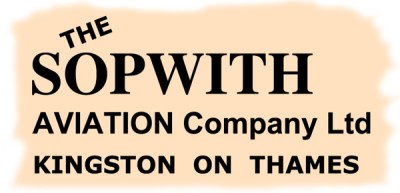 |
|
| Of the many famous aircraft manufacturers in the period 1914-1918, one of the most recognizable names would have to be that bearing Thomas Octave Murdoch Sopwith's name. The Sopwith Aviation Company Ltd of Kingston-on-Thames was formed in 1912 and produced many outstanding designs prior to its demise in 1920, some of which are illustrated here. | |
Sopwith Triplane "It seemed light and elegant and yet wiry... what it lacked in quickness it made up in the smoothness and grace of its movements. A Triplane looping looked like no other machine and gave the loops an individual quality. Irreverent pilots said it looked, when doing aerobatics, like an intoxicated flight of stairs..." so wrote Major Oliver Stewart of the Sopwith Triplane. The Triplane was an attempt to improve on the Pup's already impressive performance by replacing the Pup's two wings with three wings of reduced chord but the same span, resulting in much more lift. The reduced chord also improved the pilot's visibility. Once again the only disappointing feature was the single Vickers - which in some cases was corrected by the fitting of a second gun. So successful was the Triplane that the Germans and the French set about emulating it. | |
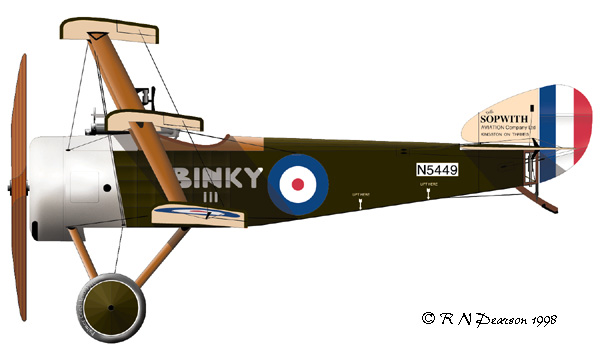 | |
| Sopwith Triplane N5449 No. 8(N) Sqn RNAS April 1917 Arriving at 8(N) on 28 February 1917 and originally named JOAN, BINKY III was photographed on its back after being overturned on landing by FSL J. A. M. Allen on 15 March 1917. F/Cdr P. A. Johnstone sent a red and green Albatros down OOC on 3 May 1917. On 10 August, FSL E. D. Crundall was forced to land after being hit by ground fire and N5449 was then shelled for eight hours. After being repaired, N5449 went to 1(N) where it was flown by FSL Spence during which he scored two victories. | |
Sopwith Camel When one thinks of First World War aviation, two aircraft types invariably come to mind. One has already been mentioned, while the other also shared the F.1 designation. The Sopwith Camel has come to symbolize (rightly or wrongly) the British fighter in WWI. Highly maneuverable and as deadly to the novice pilot as to the enemy, the Camel concentrated all its weight within the first seven feet of the fuselage. This resulted in a massive torque effect and made for very fast right hand turns. However in the hands of an inexperienced pilot this same responsiveness could be deadly and Camel accidents resulted in many deaths among its own pilots. | |
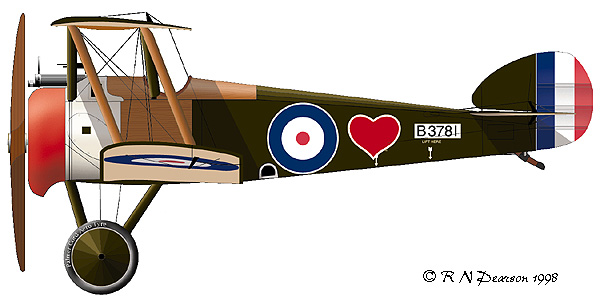 | |
| Sopwith Camel B3781 FSL J. W. P. Ellwood No. 3(N) Sqn RNAS August 1917
| 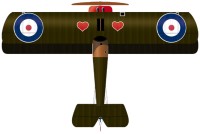 |
| On 27 August 1917, FSL J. W. P. Ellwood of No. 3(N) Sqn RNAS crashed near St. Pol. After repair B3781 went on to 9(N) and 10(N) where it was lost on 18 March 1918 with FSL G. T. Steeves being taken POW. The top view is included to show the hearts repeated on either side of the center section. Although the cowl is depicted here as being red, it may have been black. | |
Sopwith 5F.1 Dolphin The Sopwith Dolphin represented almost as radical a departure from standard Sopwith designs of the day as did the earlier Triplane. First off the Dolphin was powered by the Hispano-Suiza V-8 whereas most previous Sopwith designs made use of rotaries. However the most obvious change was the position of the upper wing. In the Dolphin the wing was lowered and featured reverse stagger. This allowed for excellent upwards visibility, but caused concern in the event of overturning. After initial wariness, the Dolphin turned out to be an excellent high-altitude fighter. The Dolphin was also the first British multi-gun fighter with two fixed Vickers and two Lewis guns in the center section. Most, however, had just one Lewis. | |
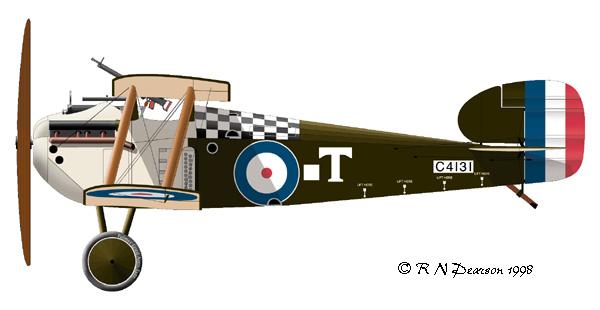 | |
| Sopwith 5F.1 Dolphin C4131 Captain William Mays Fry OC C Flight No. 79 Sqn RAF May 1918 C4131 was flown by Captain W. M. Fry when he scored his 11th victory on 11 May 1918. Also flown by Lt. V. G. Snyder, C4131 featured a black and white checkerboard on the turtledeck. | |
Sopwith 7F.1 Snipe The final Sopwith design to see widespread service was the 7F.1 Snipe. The Snipe returned to the tried and true rotary power that had served Sopwith so well, albeit the more powerful 230hp Bentley BR.2. By the Armistice of 11 November 1918, four squadrons had converted to the Snipe while postwar use saw 11 squadrons using the type. | |
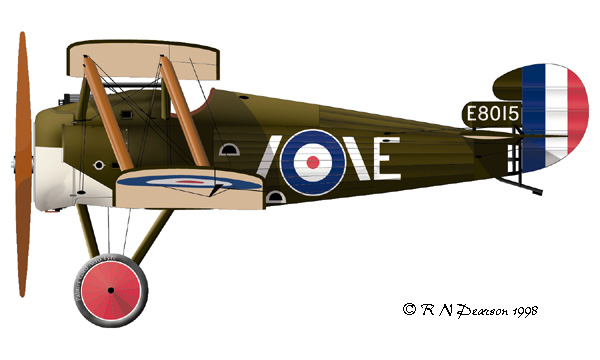 | |
| Sopwith 7F.1 Snipe E8015 Lt. Mulcair A Flight No. 43 Sqn RAF October 1918 While flying E8015 Mulcair reportedly downed a Fokker D.VII on 30 Octover 1918, however RAF Communique No. 31 makes no mention of this, but does credit him with on in No. 27 as a shared victory with Lt. R. S. Johnston. | |
| |
